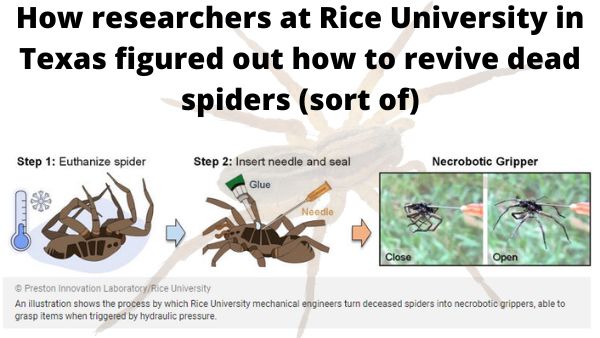How researchers at Rice University in Texas figured out how to revive dead spiders (sort of)

How researchers at Rice University in Texas figured out how to revive dead spiders (sort of) . Dead spiders can be given new life by scientists at Rice University in Houston.
It turns out that all you really need is a syringe, adhesive, and a needle.
A paper detailing how a research team at the Texas university’s engineering department was successful in repurposing dead spiders as tiny grippers, similar to those used in arcade claw machines, was posted in a science journal on Monday by professor Daniel Preston as well as graduate student Faye Yap.
Preston told USA TODAY that when moving some lab equipment, graduate student Faye “really discovered a dead spider.” “We noticed that it had its legs turned inward and was completely coiled up”. So its interested to know why that was.
That’s when Preston and Yap discovered how spiders’ unique hydraulic leg control mechanisms worked.
How do scientists control the legs of a dead spider?
According to the article, spiders only have flexor muscles that can move their legs inward, unlike humans who have antagonistic muscle pairs (think biceps). According to the article, the spider produces hydraulic pressure to move its legs.
The paper states that when a spider passes away, pressure no longer works against its flexor muscles, causing its legs to curl inward as is frequently seen in dead home spiders.
The paper states that when a spider dies, pressure no longer resists its flexor muscles, leading its legs to curl inward as is frequently seen in dead domestic spiders.
IS YOUR AGE UNDER 40? Alcohol may not be healthy for you even in modest doses, a research says.
WHAT IS RUNNING THE TALK? For the most recent information on the day, subscribe to our popular newsletter.
By injecting tiny quantities of air into dead spiders, Preston and Yap were able to transform them in their research into tiny “necrobotic” grippers.
To manage the flow of pressure into the spider’s body and via its legs, they simply define a hypodermic needle into the creature’s body, sealed it with glue, as well as linked the needle to a syringe.
Open and shut. Open and shut. No specific lab apparatus is required.
What’s the potential use for dead spider grippers?
Preston noted that although the project is still in its early stages, the dead spider grippers may have practical uses in “micro-scale manipulation,” such as taking up tiny electrical components.
Preston said, “We’re especially excited about the possibility to employ this in the field, where the fluidic grasping mechanism’s inherent compliance allows us to handle delicate or fragile materials.” “And perhaps even live insects or other creatures that we need for fieldwork,” the author adds.
According to the article, the wolf spiders utilized in the study were able to grab things that were 130% of their own mass. But Preston claimed that the idea of utilizing smaller spiders delighted him.
We came to the conclusion that little spiders really perform better after applying some mathematical scaling. The ratio of their gripping force to gripper weight will be larger, Preston said.
Because they are naturally biodegradable, Preston’s team claimed in their research that its grippers were an ecologically benign substitute for grippers composed of other materials. According to the paper, the grippers tested were good for 1,000 grips before they began to exhibit wear from dehydration. The investigation also suggested that the spider grippers’ longevity may be increased by using a specific coating.
- How to Turn Off Age Protection on TikTok?
- A Sims 4 Bug Is Aging Toddlers Into Seniors in Minutes
- How To Take Screenshots On Android Auto
Next, what? According to Preston, he aims to conduct more study to determine how to make dead spiders crawl.






